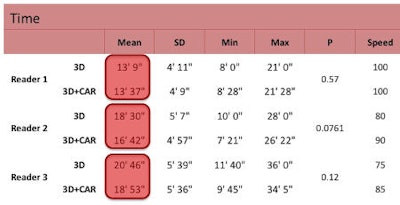
Computer-aided detection (CAD) with 3D viewing improves sensitivity for polyp detection among less experienced readers, and may also speed up reading times and reduce false-positive detections. On the other hand, the performance of experienced readers did not improve significantly with CAD use, researchers from the University of Rome concluded.
Several studies have found that "the 3D primary reading approach is the favorite approach of less experienced readers, and there are also papers that say the performance of less experienced readers is better with a 3D approach," said Dr. Riccardo Ferrari from the University of Rome "Polo Pontino" in Italy. "So we tried to compare performance of differently experienced readers with a primary 3D fly-through approach using or not using CAD software."
Ferrari and his team acquired virtual colonoscopy (also known as CT colonography or CTC) images on a 64-detector-row scanner (LightSpeed VCT, GE Healthcare, Chalfont St. Giles, U.K.) using a low-dose protocol and 1.25-mm collimation and slice thickness. Two different types of preps were used, including minimal prep with fluid tagging in 18 patients and full cathartic preparations in 32 patients.
Three radiologists with different rates of experience in CTC (reader 1 = expert, reader 2 = moderately experienced, and reader 3 = inexperienced) were asked to retrospectively analyze 50 CTC datasets from a polyp-rich population of 50 subjects, 42 of whom had colonoscopy-confirmed polypoid lesions ranging in size from 2 mm to 40 mm.
Reader 1 was a radiologist with experience in more than 500 cases over five years, Ferrari said. Reader 2 was a fourth-year radiology resident with experience in more than 100 cases. Reader 3 was a sixth-year medical student without prior VC experience. His training concluded with a mentored exam consisting of 10 cases, following a one-day theoretical course and 20 practice cases with feedback.
"First, the cases were read without the use of CAD; then, we asked them after a month to reread the datasets with the use of CAD software as a concurrent reader," Ferrari said at the 2009 European Congress of Radiology (ECR) in Vienna. Readers could take as much time as they wished, but reading sessions were limited to 10 cases.
The images were analyzed using a primary 3D method on a workstation (Viatronix, Stony Brook, NY) equipped with V3D-Colon (Version 1.3, Viatronix) software and Colon CAR (Version 1.3, Medicsight, London) software. The group analyzed per-polyp sensitivity, inter-reader agreement, mean reporting time, and false-positive detections for each approach.
"For polyps 10 mm and smaller there was no difference in the performance of the readers, but if we analyzed polyps larger than 6 mm there is a statistically significant difference in sensitivity -- especially in the less experienced readers," Ferrari said. "In inter-reader agreement, we found more agreement among readers with a [similar] level of experience."
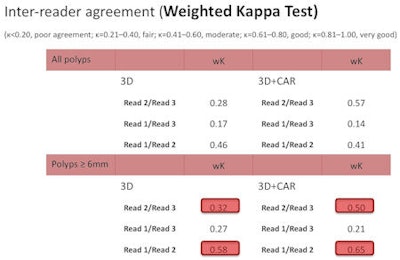 |
| Weighted kappa test shows higher inter-reader agreement among readers with similar experience levels. All images courtesy of Dr. Riccardo Ferrari. |
The two less experienced readers performed better with 3D plus CAD, increasing their per-polyp sensitivity respectively from 75% and 61% for 3D analysis to 86% and 74% for primary 3D + CAD analysis, a difference that was statistically significant (p = 0.001 and p = 0.01). No significant difference in sensitivity was found for the expert reader (p = 0.06).
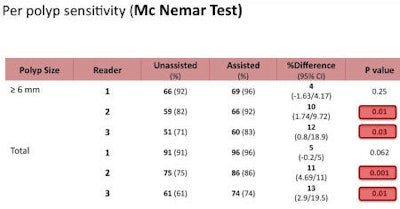 |
| Less experienced readers significantly improved their polyp detection sensitivity when assisted by the CAD software. |
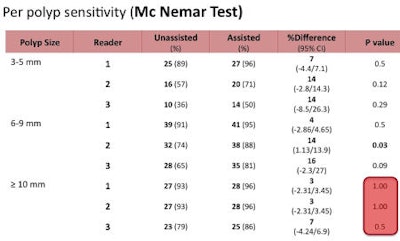 |
Less experienced readers also showed a trend toward faster reading times when assisted by the CAD software; however, there were no significant differences in the mean reading times of all readers (p = 0.5/0.07/0.1).
"We found a reduction in false positives, especially with the less experienced readers, and an improvement in the confidence level for all readers and especially the less experienced," Ferrari said. There was no significant difference in sensitivity between the fluid-tagged and the fully cleansed data, overall, and no difference in performance among the differently experienced readers interpreting them, he said.
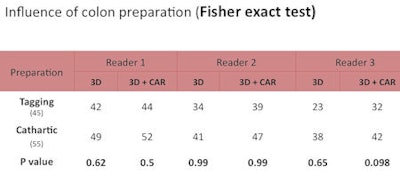 |
| Fisher's exact test results showed a trend toward higher sensitivity with the use of a cathartic bowel preparation; however, the difference was not significant. |
The mean number of false-positive detections in the CAD analysis was 12 (± 13 standard deviation). There was a decrease in false positives for all readers when assisted by CAD, especially the two less experienced readers. Inter-reader agreement was higher among all readers when assisted by CAD (0.33 to 0.63, 0.39 to 0.62, and 0.58 to 0.65).
Finally, less experienced readers were faster when assisted by CAD, but no significant differences were found in the mean reading times of all readers (p = 0.5/0.07/0.1).
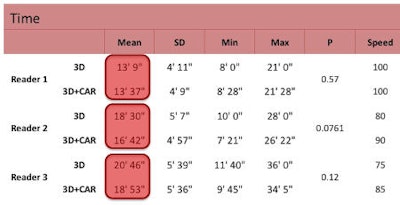 |
| Less experienced readers had faster reporting times when assisted by CAD. |
The sensitivity of less experienced readers improved using the CAD software as a concurrent reader, and CAD assistance increased the confidence level of the less experienced readers, Ferrari concluded.
"There are still some key points to analyze, including why there was a reduction in the reporting time, and, of course, because the less experienced readers speeded up, there is also a possibility that the inexpert readers between the first and the second sessions improved on their learning curve," Ferrari said. "But at the end, we cannot exclude bias."
The study is being repeated using CAD at the initial review and without CAD during the second reading a month later, he said.
By Eric Barnes
AuntMinnie.com staff writer
April 21, 2009
Related Reading
Virtual colonoscopy CAD finds most cancers, April 3, 2009
Adding CAD to virtual colonoscopy saves lives and money, February 24, 2009
Virtual colonoscopy beginners do better with 3D data, February 5, 2009
Image tools cut false positives in unprepped VC, August 4, 2008
VC CAD improves results for readers at all levels, April 7, 2006
Copyright © 2009 AuntMinnie.com
















